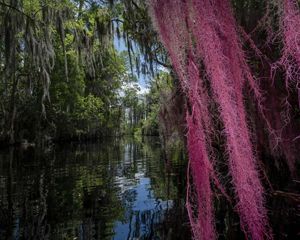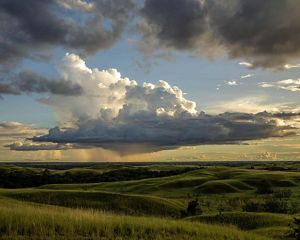
Green Harvest
For decades, a piece of legislation has had an outsized impact on protecting America’s landscapes. Now the U.S. Farm Bill is up for renewal again.
Text by Ginger Strand | Photographs by Morgan Heim | Issue 3, 2024
Most of us think of the Farm Bill—if we think of it at all—as a relic of the Dust Bowl: a 90-year-old bill providing money for farmers and guidelines for soil conservation. But it’s much more than that. It’s the “most important legislation” for conserving, managing and restoring private lands in the United States, says Jenny Conner Nelms, associate director of legislative affairs at The Nature Conservancy. It has a major impact on American supply chains, too, she says, incentivizing businesses to work in more environmentally friendly ways. The last bill included around $6 billion a year for things like protecting watersheds, sustaining forests and addressing climate change. The next one, expected within a year, could direct even more funds to conservation, an increasingly important goal of this omnibus legislation.
It wasn’t always so. The Farm Bill’s history tracks the nation’s. The first bill, in 1933, was part of Franklin D. Roosevelt’s New Deal. The Depression had hit farmers—a substantial share of the United States’ workforce—hard. As crop prices fell, some families lost their farms. The act set price supports and paid farmers not to grow certain crops to avoid surpluses. But when those production limits led to fields being plowed under and hogs being killed—even as many folks struggled to put food on the table—outcries led to a new idea: buy excess goods for distribution to the needy.
The Farm Bill thus began as a governmental attempt to manage two important and linked things: agricultural markets and food security. An ecological disaster—the Dust Bowl—led to an additional objective: soil conservation. The legislation was expanded to encourage farmers to maintain the health of their cropland.
Renewed every five years, the Farm Bill has continued to evolve alongside political priorities. “The Farm Bill is a kind of Christmas tree where many different interest groups can hang something,” says Sarah Phillips, an associate professor of history at Boston University, specializing in agriculture policy.
How the Farm Bill Translates Into Conservation
Hear from each of the Farm Bill beneficiaries photographed in this story.
Watch Video HereConservation benefits of the Farm Bill
Today the bill helps far more people than just farmers: Nutrition spending, including for the Supplemental Nutrition Assistance Program (SNAP), which provides food-purchasing assistance for low-income families, now accounts for three-quarters of the bill’s budget. The 1980s saw the addition of rural development programs as well as funding for conservation projects.
That’s because, while farmers are decreasing as a percentage of the population, agricultural land remains a large part of the country’s land base. It makes up nearly half of the continental United States. What farmers, ranchers and forest landowners do—how they manage lands, how they use water, how they treat soils—is critically important to the health of landscapes and neighboring communities. This has brought environmental groups like The Nature Conservancy into the conversation. “It helps that we come to the table not just as environmental advocates, but as owners and operators of agricultural lands and timberlands ourselves,” says Conner Nelms.
The Nature Conservancy is part of the Food and Agriculture Climate Alliance, a group made up of national agriculture and conservation organizations that has developed recommendations for this legislation. For the Farm Bill currently being discussed, TNC has recommended prioritizing six areas:
- bolstering incentives for regenerative agriculture methods that can repair soil health
- encouraging conservation of sensitive habitats, especially intact grasslands
- improving water quality and supply
- accelerating the clean energy transition in rural America
- maintaining healthy and resilient forests
- promoting equity and inclusion for disadvantaged farmers in U.S. Department of Agriculture programs
“This is not just wishful thinking,” he says. In fact, healthy working lands can create a healthier environment.
How Farm Bill programs help Americans and support conservation
Hauser Family: Farming in Arizona
Along Arizona’s Verde River, the Hauser family grows pecans, sweet corn, barley and other crops on 700 acres. Family matriarch Claudia Hauser credits a series of deals funded by TNC and Farm Bill programs with helping keep the land in the family. In 2016 and 2018, TNC used Farm Bill funding to buy the development rights on two parcels of land the Hausers had been renting, which enabled the family to buy them outright and place them under conservation easements. The family also used Farm Bill programs to help finance water-saving projects that make their farm more resilient and keep water in the river.
Hatcher Family: Ranching in Kansas
Treg Hatcher’s ranch has been in his family since the 1960s, but about 15 years ago he worried he might have to let it go. During a drought in southwestern Kansas, grasses died, leaving little food for his livestock. Hatcher had already begun experimenting with rotational grazing, but to expand it would require new, expensive infrastructure like watering troughs. With funding from a program supported by the Farm Bill, Hatcher was able to buy new troughs and expand his efforts in rotational grazing—efforts that allowed parts of the pastures to recover and the grass to regrow. Today the Hatcher family ranch is healthy again. “The grass has never been as tall as it is now,” Hatcher says.
Saloom Family: Forestry in Alabama
In 1983, Salem Saloom, now a semiretired physician and Episcopalian priest-in-training, bought 160 acres of former farmland in Alabama as a hunting retreat, but he soon fell in love with forestry. Saloom and his family spent the next two decades planting trees like loblolly pines and caring for the property. But when Hurricane Ivan, a Category 3 storm, hit the Gulf Coast in 2004, the property suffered extensive damage. In response, Saloom and his wife, Dianne, turned to a program under the Farm Bill for help. In 2006, they received funding to begin planting longleaf pines, a slower-growing but more storm-resistant tree that provides important habitat for plant and animal species in the Southeast. Since then, the family has planted 1,100 acres of longleaf forest.
Martin Family: Farming in North Carolina
Carrie and Erin Martin grow a variety of fruits and vegetables on their farm in North Carolina—land that has been in their family for more than 140 years. When the Martins decided to expand their operations several years ago, they used funding from a Farm Bill program to help pay for a high tunnel, a type of greenhouse that can extend the growing season and provide a more controlled environment for building rich, healthy soil. Like many small-scale farmers, the mother-and-daughter team is committed to growing their business and providing food for their community even as they hold down other jobs. The experience has turned both into strong advocates for small farmers and for greater access to the programs and funding available through the Farm Bill.
About the Creators
Ginger Strand is a writer based in New York and the author of four books. No stranger to the Farm Bill, she grew up on a Michigan farm.
Morgan Heim is a photojournalist whose work has been published in National Geographic, Audubon and elsewhere.

Magazine Stories in Your Inbox
Sign up for the Nature News email and receive conservation stories each month.











